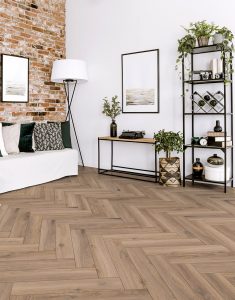Rustic oak floor offers a timeless look that blends natural character with durable performance. Its surface shows knots, grain variation, and color shifts that highlight the natural story of the wood. This kind of flooring is often chosen for its ability to add warmth, charm, and a handcrafted appearance to both traditional and modern interiors.

Understanding Rustic Oak Floor Characteristics
Rustic oak floors are defined by their visible imperfections. These include mineral streaks, cracks, checks, and open knots. Rather than defects, these features are celebrated for the unique personality they give each plank. This flooring type is commonly finished with techniques that enhance texture, such as wire-brushing or hand-scraping.
Natural Variation
No two planks are exactly alike. Color differences within the same batch are common and expected, making rustic oak ideal for those who want organic diversity rather than a uniform appearance.
Texture and Finish
Rustic oak floors often receive low-sheen finishes like matte or oiled coatings. These finishes bring out the grain while offering practical benefits such as hiding scratches or dents in high-traffic areas.
Popular Styles and Design Applications
The charm of rustic oak is that it suits a variety of interior styles. From farmhouse kitchens to minimalist lofts, the texture and tone can be adapted to different aesthetics with the right pairing of wall color, furniture, and lighting.
Country and Farmhouse Style
In these settings, rustic oak pairs well with vintage décor, open shelving, and cozy fabrics. Its rugged finish brings a sense of history and comfort to the space.
Industrial and Loft Interiors
Rustic oak complements raw elements like exposed brick or black steel. The natural grain balances out the harshness of concrete or metal, adding organic contrast to otherwise hard-edged rooms.
Scandinavian and Minimalist Homes
Light-toned rustic oak is increasingly used in minimalist settings. When combined with white walls and simple furniture, it delivers visual warmth while keeping the overall palette light and airy.
Installation Options and Formats
Rustic oak flooring is available in solid and engineered formats. The right choice depends on subfloor conditions, location, and long-term goals.
Solid Rustic Oak
This type is milled from a single piece of hardwood. It can be sanded and refinished multiple times, making it suitable for homeowners who want longevity and the ability to refresh the floor over decades.
Engineered Rustic Oak
Engineered boards feature a top layer of rustic oak bonded over plywood or HDF. They are more dimensionally stable and suitable for basements or rooms with radiant heating systems.
Maintenance and Longevity
Despite its rougher look, rustic oak is easy to care for. Its varied appearance makes everyday wear and tear less noticeable, extending the floor’s visual appeal.
Cleaning Tips
Use a dry microfiber mop for daily dust removal. For deeper cleaning, use wood-safe pH-neutral cleaners. Avoid soaking the floor, as excess moisture can damage the wood over time.
Scratch and Dent Management
Due to its textured surface, rustic oak conceals small dents and scratches better than smooth or glossy finishes. Touch-up kits with matching stain can be used for quick fixes when needed.
Sustainability and Sourcing
Many rustic oak flooring products are made from responsibly sourced European or North American white oak. Look for certifications like FSC or PEFC to ensure that the wood is harvested with sustainable practices in mind.
Reclaimed Rustic Oak
Another eco-friendly option is reclaimed rustic oak, salvaged from barns or old structures. It offers rich character, aged patina, and a history that’s impossible to replicate in new materials.
Low-VOC Finishes
Modern rustic oak floors are often coated with low-VOC finishes that reduce indoor air pollution. This makes them safer for children, pets, and those with allergies or chemical sensitivities.




